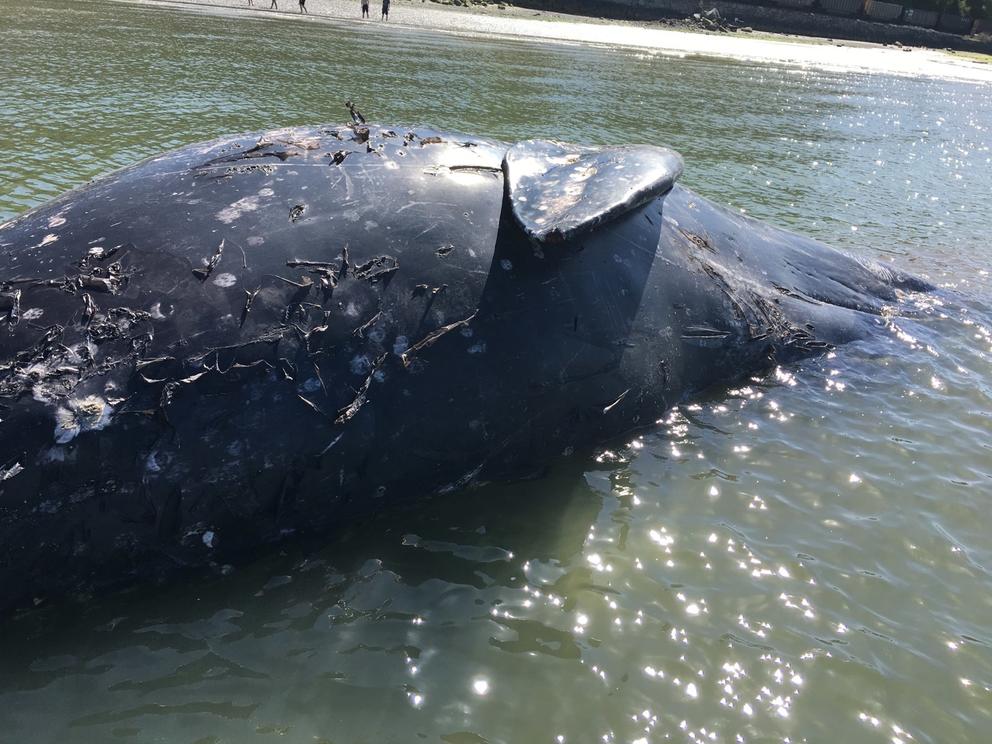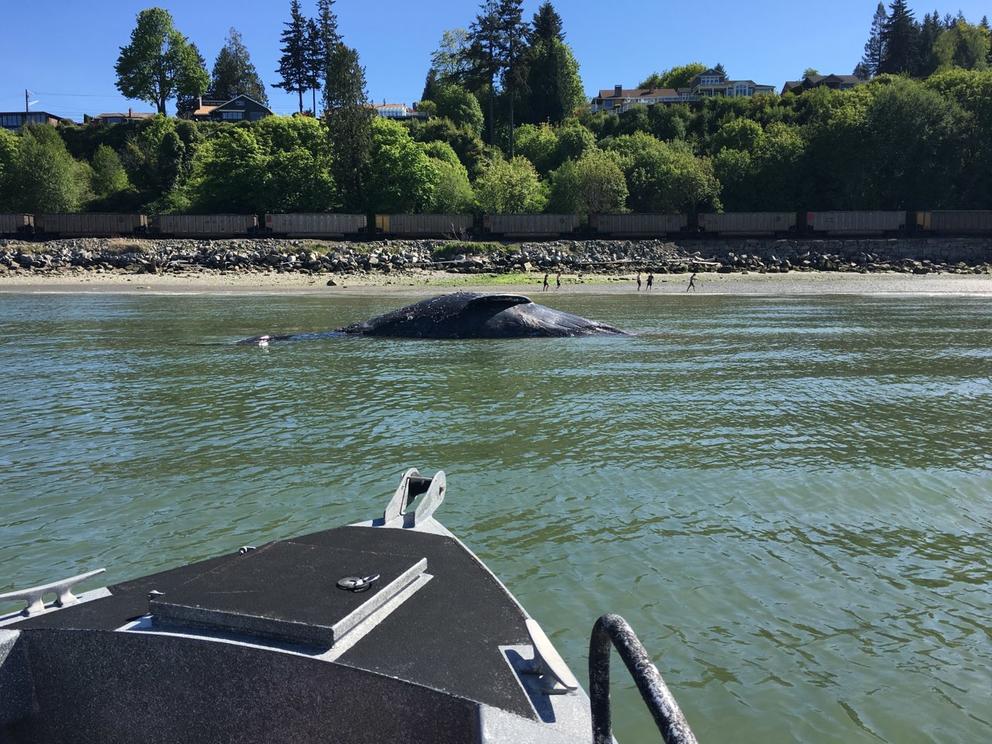Calambokidis is part of the Northwest Marine Mammal Stranding Network, a 39-year-old coalition of scientists and volunteer networks coordinated by the National Oceanic and Atmospheric Administration. The Cascadia team often performs necropsies on these animals, while groups like the Washington Department of Fish and Wildlife transport them from peopled locations to shorelines where they can decompose naturally.
Washington responders typically see only four to eight beached gray whales each year. But Calambokidis says the network has already responded to 18 dead whales in 2019 as of Monday. There have been six confirmed beachings since May 3, including the whale found at Harborview, says NOAA Fisheries’ Kristin Wilkinson, the stranding coordinator for Washington and Oregon. The most recent whale was found by North Cove near Westport.
Calambokidis says the “rapidly changing” number of strandings is unusual. “To already be at [18], and we're still early in the season, we’re certainly way above normal,” he says.
Calambokidis’ team performed a necropsy Thursday on the whale found at Harborview; on Friday, his colleague Jessie Huggins performed a necropsy on a second, and the Department of Fish and Wildlife performed one on a third. According to a Friday press release, the Harborview whale necropsy showed the animal was a 42-foot female adult whose “cause of death was not immediately apparent but appeared consistent with nutritional stress.”
“Both animals from Friday were juvenile males and, yes, preliminary results were consistent with malnutrition,” Huggins says. “No age or gender details [are] available on the most recent animal yet.”
According to seattlepi.com, California, Oregon and Washington had collectively observed 45 strandings as of May 6 this year; they saw 25 over all of 2018. (April and May, according to the most recent decade-long data, are the peak season for Northwest gray whale strandings.) In 2018, there were 13 strandings total along the Washington shoreline.
It’s an alarming sight when 60,000 pounds of an adult gray whale hit a beach. With so many strandings in such a short time period, the optics of whale health might seem dire. But scientists and officials still aren’t sure what’s behind the uptick in cetacean deaths: While the strandings are abnormal, they may not yet be cause for concern for whale populations as a whole.
Healthy population = more dead whales?
Of leading hypotheses for the increased number, one is somewhat counterintuitive: namely, that an essentially healthy gray whale population will see a proportional rise in stranding deaths.
The eastern north Pacific gray whale population — the one that skims the coastline on a 1,300-mile journey from its winter home in Baja to summertime Arctic feeding grounds — has made incredible strides since being depleted by centuries of whaling, to as low as 4,000 by the mid-1800s.
Many conservation efforts were enacted in response, from international whaling bans in the 1930s to the Endangered Species Act and Marine Mammal Protection Act in the 1970s to oil- and gas-leasing moratoriums in 1980s California and beyond. By 1994, the population reached about 21,000 animals and was delisted from Endangered Species Act protection. Today, sources estimate the population fluctuates between 25,000 and 27,000.
“The more whales you have, the more whales that are going to die,” says Michael Milstein, public affairs officer of NOAA Fisheries. “So it's not totally unexpected that we'd see an increasing trend in whale strandings. But certainly, this has picked up quite quickly and the numbers have risen pretty substantially in the last year.”
That increase in whale deaths might simply indicate how many whales the Pacific Ocean can reasonably sustain — something ecologists call “carrying capacity.”
While the necropsied animals so far are of both genders and all ages, “the one common thread seems to be that many of these whales are skinny and undernourished,” Milstein says. If more whales are competing for food, some of them might not be getting enough.
Scientists have observed some of the whales were emaciated enough for ribs to show. “They basically don’t have the body size and capacity that they typically would at this time of year [to get back to the Arctic for summer feedings] ... which mostly lasts them through the rest of the year,” Milstein says, “so for some reason some of these whales didn’t put on as much weight last summer, and have not had enough energy to make it all the way back there for the next feeding seasons.”
But scientists can’t rule out starving whales as a sign that something is amiss in their ecosystem. “[Strandings] could be exacerbated by changes in the environment — [gray whales] are a good reflection of what’s going on in the ocean,” Milstein says. “The bigger the population, the more sensitive it’s going to be to environmental changes.”
Millstein says this could be a sign of a decline in quantity, quality and availability of food. Because gray whales eat arthropods — insectlike creatures at the very bottom of the food chain — arthropod health impacts animal health all the way up the chain.
“The same thing that’s affecting [gray whales] may affect other species in different ways, if they either depend on the same food sources, or depend on food sources higher in the food web,” Milstein says.
NOAA’s Alaska Fisheries Science Center is investigating arthropod health in whale feeding areas, he says.
For whatever reason, the whales have also been exhibiting strange behavior this year, Milstein says. Whales don’t often come into Puget Sound, but more of them have been venturing into bays and sounds than usual.
“It's not uncommon for whales to duck into the bays on their way north from time to time, but then typically they’ll head back out and continue their migration to the Arctic,” he says. “ It’s not the main migration route by any means. So why these whales are stopping off in the bays and sounds is an open question. Given the increase of population, they may be looking for more habitat that hasn’t been occupied. They may be resting on their migration north or they may be running out of energy, like some of them seem to be.”
“We’re very interested in watching the [whale strandings] from that standpoint that they can be a reflection of the overall condition of the ocean,” Milstein says, “But we don’t see this as a threat to the population as a whole.”
Between the mortalities and strange behavior, though, Cascadia is conducting a survey for live whales.
“Along with these elevated mortalities, we often get gray whales in unusual areas or in poor body conditions that are sighted alive,” Calambokidis says. “Right now we’re surveying [Whidbey], an area where we often get almost every year the same dozen or so returning gray whales that feed here normally, and are part of a healthy dynamic, but we're surveying this area to look at which whales are here, are they the same whales we've seen in past years, and do they appear to be in good health or not.”
Looking to history
This isn’t the first strange uptick in gray whale deaths in recent history. A similar spike took place over two years in 1999 and 2000, when 651 whales beached across the West Coast and the total population fell to 16,000. Almost 50 whales stranded themselves in Washington state.
Scientists still aren’t sure why that spike happened: Only three of those animals were necropsied, and all three were emaciated. Scientists observed that many other dead and living whales were also visibly underweight.
“That was part of a major mortality event, throughout the range of the eastern north Pacific grey whale, and that seems to be what’s developing here,” Calambokidis says. “But we're still early in the season. Peak mortality is April, May and June, so we're not even through our peak period.”
Depending on how this season pans out, scientists may be able to establish patterns between the two stranding crises. Scientists in California are already noting that there are fewer calves than normal making their way north, which can occur when mothers are too thin to carry babies to term.
Nevertheless, the population rebounded after the millennial stranding crisis. “The whale population as a whole is very resilient and healthy and has demonstrated that with the right protections and conservation measures, the population can do very well and flourish,” Milstein says.
Stressed-out responders
Whether whale deaths are indicative of something ominous or not, sources say there is concern for our ability to manage increased deaths. In a stranding response, volunteers work with NOAA, the Fish and Wildlife Department and local officials to remove whales from highly public areas to undisclosed shores suited to natural decomposition. Of the five stranded whales this month, all but the Harborview whale washed up on an outer coastal beach and was allowed to decompose where they landed. The Fish and Wildlife Department towed the Harborview animal by service boat.
The decomposition process typically takes up to two months, Wilkinson says; necropsied animals take about a month.
“[NOAA is] congressionally mandated to collect Level A data, which is very basic data on marine mammal strandings,” Wilkinson says. That data includes genus, species, initial observation, day of response, the condition of the carcass, whether the animal is alive, and more.
If the body is in good enough condition and accessible, NOAA performs necropsies to determine cause of death. Occasionally, samples are sent to a pathologist in Seattle.
In rare occasions, organizations with authorization letters can claim cleaned whale skeletons for educational purposes, Wilkinson says. Seattle Pacific University is currently going through the process of claiming a whale that stranded in February.
This takes lots of human effort and funding. Wilkinson says that removal and relocation of a single whale on average costs $10,000 to $14,000; six scientists were needed to perform the Harborview necropsy. Sinking a whale carcass requires expensive ocean dumping permits through the Environmental Protection Agency. Field responders in the stranding network rely significantly on grants to supplement NOAA funding.
“It’s costly and complicated” to move a whale, Wilkinson says, especially in Puget Sound “due to the high human population and limited beach availability.”
“To do a necropsy you need at least a few people, and they need to be experienced, and there's a limit to that expertise that we have, so we really rely on our stranding network,” Milstein says. “All these groups are responding to more whales than we’ve seen in many years and that takes time and effort, and we couldn’t do it without them.”
Despite the stress, there are reasons to be hopeful, Calambokidis adds.
“We did today see at least seven healthy gray whales feeding in northern Puget Sound, so it’s not all doom and gloom,” he says. “Some of the animals up here in North Puget Sound that we saw today are animals we first identified in 1990, so we’ve seen them now for almost 30 years. And that was just in our survey today, so we’re kind of encouraged."
Get the best stories of the week
This weekly newsletter dives deeper into one story and how it was reported, along with curating the best stories of the week.




